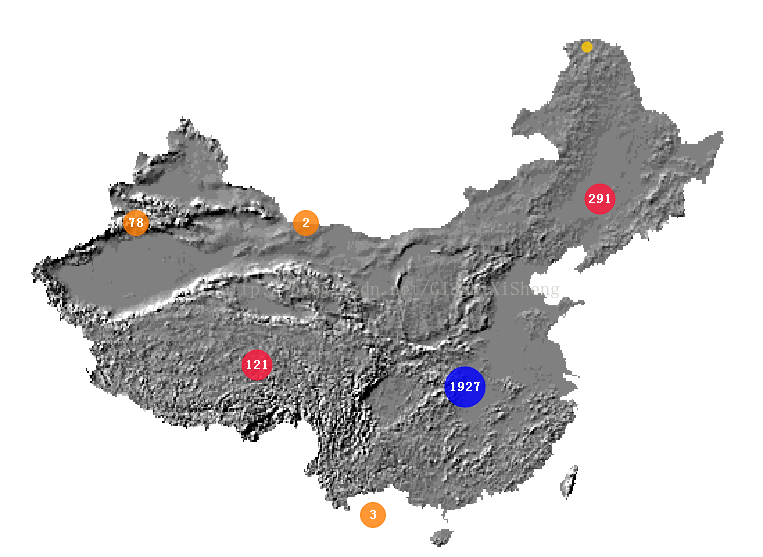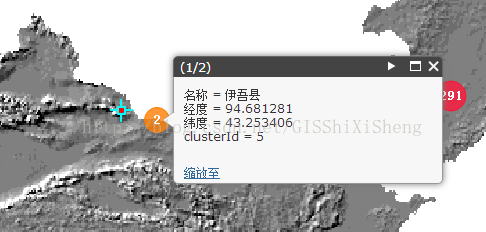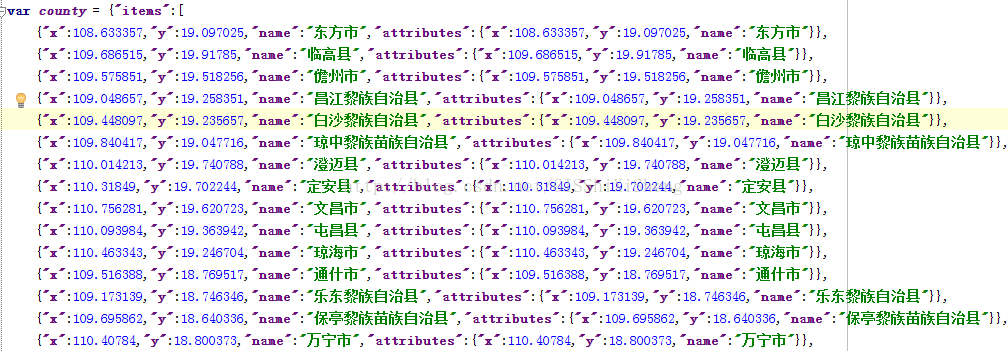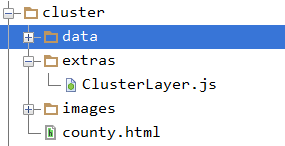(转)Arcgis for JS之Cluster聚类分析的实现
http://blog.csdn.net/gisshixisheng/article/details/40711075
在做项目的时候,碰见了这样一个问题:给地图上标注点对象,数据是从数据库来的,包含XY坐标信息的,通过graphic和graphiclayer 的方式添加到地图上,其中有一个对象的数量很多,上万了吧,通过上述的方式无法在地图上进行展示,就想到了聚类,当时由于技术和时间的关系,没有实现,最近,稍微有点先下时间,就又想起这事,继续研究,终于,皇天不负有心人,出来了,出来的第一时间写出来,以便大家使用。
首先,看看实现后的效果:

初始化状态

点击对象显示详细对象和信息框

放大后的效果
效果就是上面所示的这个样子的,下面说说实现的步骤与思路:
1、数据
正常数据的来源是源自数据库的JSON数据,在本例子中,新建了一个变量用来模拟JSON数据,我所用的数据是全国的市县级的点状数据转换来的,如下:

2、clusterLayer的封装
根据需求,对GraphicsLayer进行了封装为clusterLayer,来源为Arcgis for JS官方实例,对其中个别代码做了修改,源代码如下:
- define([
- "dojo/_base/declare",
- "dojo/_base/array",
- "esri/Color",
- "dojo/_base/connect",
- "esri/SpatialReference",
- "esri/geometry/Point",
- "esri/graphic",
- "esri/symbols/SimpleMarkerSymbol",
- "esri/symbols/TextSymbol",
- "esri/dijit/PopupTemplate",
- "esri/layers/GraphicsLayer"
- ], function (
- declare, arrayUtils, Color, connect,
- SpatialReference, Point, Graphic, SimpleMarkerSymbol, TextSymbol,
- PopupTemplate, GraphicsLayer
- ) {
- return declare([GraphicsLayer], {
- constructor: function(options) {
- // options:
- // data: Object[]
- // Array of objects. Required. Object are required to have properties named x, y and attributes. The x and y coordinates have to be numbers that represent a points coordinates.
- // distance: Number?
- // Optional. The max number of pixels between points to group points in the same cluster. Default value is 50.
- // labelColor: String?
- // Optional. Hex string or array of rgba values used as the color for cluster labels. Default value is #fff (white).
- // labelOffset: String?
- // Optional. Number of pixels to shift a cluster label vertically. Defaults to -5 to align labels with circle symbols. Does not work in IE.
- // resolution: Number
- // Required. Width of a pixel in map coordinates. Example of how to calculate:
- // map.extent.getWidth() / map.width
- // showSingles: Boolean?
- // Optional. Whether or graphics should be displayed when a cluster graphic is clicked. Default is true.
- // singleSymbol: MarkerSymbol?
- // Marker Symbol (picture or simple). Optional. Symbol to use for graphics that represent single points. Default is a small gray SimpleMarkerSymbol.
- // singleTemplate: PopupTemplate?
- // PopupTemplate</a>. Optional. Popup template used to format attributes for graphics that represent single points. Default shows all attributes as "attribute = value" (not recommended).
- // maxSingles: Number?
- // Optional. Threshold for whether or not to show graphics for points in a cluster. Default is 1000.
- // webmap: Boolean?
- // Optional. Whether or not the map is from an ArcGIS.com webmap. Default is false.
- // spatialReference: SpatialReference?
- // Optional. Spatial reference for all graphics in the layer. This has to match the spatial reference of the map. Default is 102100. Omit this if the map uses basemaps in web mercator.
- this._clusterTolerance = options.distance || 50;
- this._clusterData = options.data || [];
- this._clusters = [];
- this._clusterLabelColor = options.labelColor || "#000";
- // labelOffset can be zero so handle it differently
- this._clusterLabelOffset = (options.hasOwnProperty("labelOffset")) ? options.labelOffset : -5;
- // graphics that represent a single point
- this._singles = []; // populated when a graphic is clicked
- this._showSingles = options.hasOwnProperty("showSingles") ? options.showSingles : true;
- // symbol for single graphics
- var SMS = SimpleMarkerSymbol;
- this._singleSym = options.singleSymbol || new SMS("circle", 6, null, new Color(options.singleColor));
- this._singleTemplate = options.singleTemplate || new PopupTemplate({ "title": "", "description": "{*}" });
- this._maxSingles = options.maxSingles || 1000;
- this._webmap = options.hasOwnProperty("webmap") ? options.webmap : false;
- this._sr = options.spatialReference || new SpatialReference({ "wkid": 102100 });
- this._zoomEnd = null;
- },
- // override esri/layers/GraphicsLayer methods
- _setMap: function(map, surface) {
- // calculate and set the initial resolution
- this._clusterResolution = map.extent.getWidth() / map.width; // probably a bad default...
- this._clusterGraphics();
- // connect to onZoomEnd so data is re-clustered when zoom level changes
- this._zoomEnd = connect.connect(map, "onZoomEnd", this, function() {
- // update resolution
- this._clusterResolution = this._map.extent.getWidth() / this._map.width;
- this.clear();
- this._clusterGraphics();
- });
- // GraphicsLayer will add its own listener here
- var div = this.inherited(arguments);
- return div;
- },
- _unsetMap: function() {
- this.inherited(arguments);
- connect.disconnect(this._zoomEnd);
- },
- // public ClusterLayer methods
- add: function(p) {
- // Summary: The argument is a data point to be added to an existing cluster. If the data point falls within an existing cluster, it is added to that cluster and the cluster's label is updated. If the new point does not fall within an existing cluster, a new cluster is created.
- //
- // if passed a graphic, use the GraphicsLayer's add method
- if ( p.declaredClass ) {
- this.inherited(arguments);
- return;
- }
- // add the new data to _clusterData so that it's included in clusters
- // when the map level changes
- this._clusterData.push(p);
- var clustered = false;
- // look for an existing cluster for the new point
- for ( var i = 0; i < this._clusters.length; i++ ) {
- var c = this._clusters[i];
- if ( this._clusterTest(p, c) ) {
- // add the point to an existing cluster
- this._clusterAddPoint(p, c);
- // update the cluster's geometry
- this._updateClusterGeometry(c);
- // update the label
- this._updateLabel(c);
- clustered = true;
- break;
- }
- }
- if ( ! clustered ) {
- this._clusterCreate(p);
- p.attributes.clusterCount = 1;
- this._showCluster(p);
- }
- },
- clear: function() {
- // Summary: Remove all clusters and data points.
- this.inherited(arguments);
- this._clusters.length = 0;
- },
- clearSingles: function(singles) {
- // Summary: Remove graphics that represent individual data points.
- var s = singles || this._singles;
- arrayUtils.forEach(s, function(g) {
- this.remove(g);
- }, this);
- this._singles.length = 0;
- },
- onClick: function(e) {
- // remove any previously showing single features
- this.clearSingles(this._singles);
- // find single graphics that make up the cluster that was clicked
- // would be nice to use filter but performance tanks with large arrays in IE
- var singles = [];
- for ( var i = 0, il = this._clusterData.length; i < il; i++) {
- if ( e.graphic.attributes.clusterId == this._clusterData[i].attributes.clusterId ) {
- singles.push(this._clusterData[i]);
- }
- }
- if ( singles.length > this._maxSingles ) {
- alert("Sorry, that cluster contains more than " + this._maxSingles + " points. Zoom in for more detail.");
- return;
- } else {
- // stop the click from bubbling to the map
- e.stopPropagation();
- this._map.infoWindow.show(e.graphic.geometry);
- this._addSingles(singles);
- }
- },
- // internal methods
- _clusterGraphics: function() {
- // first time through, loop through the points
- for ( var j = 0, jl = this._clusterData.length; j < jl; j++ ) {
- // see if the current feature should be added to a cluster
- var point = this._clusterData[j];
- var clustered = false;
- var numClusters = this._clusters.length;
- for ( var i = 0; i < this._clusters.length; i++ ) {
- var c = this._clusters[i];
- if ( this._clusterTest(point, c) ) {
- this._clusterAddPoint(point, c);
- clustered = true;
- break;
- }
- }
- if ( ! clustered ) {
- this._clusterCreate(point);
- }
- }
- this._showAllClusters();
- },
- _clusterTest: function(p, cluster) {
- var distance = (
- Math.sqrt(
- Math.pow((cluster.x - p.x), 2) + Math.pow((cluster.y - p.y), 2)
- ) / this._clusterResolution
- );
- return (distance <= this._clusterTolerance);
- },
- // points passed to clusterAddPoint should be included
- // in an existing cluster
- // also give the point an attribute called clusterId
- // that corresponds to its cluster
- _clusterAddPoint: function(p, cluster) {
- // average in the new point to the cluster geometry
- var count, x, y;
- count = cluster.attributes.clusterCount;
- x = (p.x + (cluster.x * count)) / (count + 1);
- y = (p.y + (cluster.y * count)) / (count + 1);
- cluster.x = x;
- cluster.y = y;
- // build an extent that includes all points in a cluster
- // extents are for debug/testing only...not used by the layer
- if ( p.x < cluster.attributes.extent[0] ) {
- cluster.attributes.extent[0] = p.x;
- } else if ( p.x > cluster.attributes.extent[2] ) {
- cluster.attributes.extent[2] = p.x;
- }
- if ( p.y < cluster.attributes.extent[1] ) {
- cluster.attributes.extent[1] = p.y;
- } else if ( p.y > cluster.attributes.extent[3] ) {
- cluster.attributes.extent[3] = p.y;
- }
- // increment the count
- cluster.attributes.clusterCount++;
- // attributes might not exist
- if ( ! p.hasOwnProperty("attributes") ) {
- p.attributes = {};
- }
- // give the graphic a cluster id
- p.attributes.clusterId = cluster.attributes.clusterId;
- },
- // point passed to clusterCreate isn't within the
- // clustering distance specified for the layer so
- // create a new cluster for it
- _clusterCreate: function(p) {
- var clusterId = this._clusters.length + 1;
- // console.log("cluster create, id is: ", clusterId);
- // p.attributes might be undefined
- if ( ! p.attributes ) {
- p.attributes = {};
- }
- p.attributes.clusterId = clusterId;
- // create the cluster
- var cluster = {
- "x": p.x,
- "y": p.y,
- "attributes" : {
- "clusterCount": 1,
- "clusterId": clusterId,
- "extent": [ p.x, p.y, p.x, p.y ]
- }
- };
- this._clusters.push(cluster);
- },
- _showAllClusters: function() {
- for ( var i = 0, il = this._clusters.length; i < il; i++ ) {
- var c = this._clusters[i];
- this._showCluster(c);
- }
- },
- _showCluster: function(c) {
- var point = new Point(c.x, c.y, this._sr);
- this.add(
- new Graphic(
- point,
- null,
- c.attributes
- )
- );
- // code below is used to not label clusters with a single point
- if ( c.attributes.clusterCount == 1 ) {
- return;
- }
- // show number of points in the cluster
- var font = new esri.symbol.Font()
- .setSize("10pt")
- .setWeight(esri.symbol.Font.WEIGHT_BOLD);
- var label = new TextSymbol(c.attributes.clusterCount)
- .setColor(new Color(this._clusterLabelColor))
- .setOffset(0, this._clusterLabelOffset)
- .setFont(font);
- this.add(
- new Graphic(
- point,
- label,
- c.attributes
- )
- );
- },
- _addSingles: function(singles) {
- // add single graphics to the map
- arrayUtils.forEach(singles, function(p) {
- var g = new Graphic(
- new Point(p.x, p.y, this._sr),
- this._singleSym,
- p.attributes,
- this._singleTemplate
- );
- this._singles.push(g);
- if ( this._showSingles ) {
- this.add(g);
- }
- }, this);
- this._map.infoWindow.setFeatures(this._singles);
- },
- _updateClusterGeometry: function(c) {
- // find the cluster graphic
- var cg = arrayUtils.filter(this.graphics, function(g) {
- return ! g.symbol &&
- g.attributes.clusterId == c.attributes.clusterId;
- });
- if ( cg.length == 1 ) {
- cg[0].geometry.update(c.x, c.y);
- } else {
- console.log("didn't find exactly one cluster geometry to update: ", cg);
- }
- },
- _updateLabel: function(c) {
- // find the existing label
- var label = arrayUtils.filter(this.graphics, function(g) {
- return g.symbol &&
- g.symbol.declaredClass == "esri.symbol.TextSymbol" &&
- g.attributes.clusterId == c.attributes.clusterId;
- });
- if ( label.length == 1 ) {
- // console.log("update label...found: ", label);
- this.remove(label[0]);
- var newLabel = new TextSymbol(c.attributes.clusterCount)
- .setColor(new Color(this._clusterLabelColor))
- .setOffset(0, this._clusterLabelOffset);
- this.add(
- new Graphic(
- new Point(c.x, c.y, this._sr),
- newLabel,
- c.attributes
- )
- );
- // console.log("updated the label");
- } else {
- console.log("didn't find exactly one label: ", label);
- }
- },
- // debug only...never called by the layer
- _clusterMeta: function() {
- // print total number of features
- console.log("Total: ", this._clusterData.length);
- // add up counts and print it
- var count = 0;
- arrayUtils.forEach(this._clusters, function(c) {
- count += c.attributes.clusterCount;
- });
- console.log("In clusters: ", count);
- }
- });
- });
3、ClusterLayer的导入与引用

文件目录
如上图所示文件目录,dojo导入的方式为:
- <script>
- // helpful for understanding dojoConfig.packages vs. dojoConfig.paths:
- // http://www.sitepen.com/blog/2013/06/20/dojo-faq-what-is-the-difference-packages-vs-paths-vs-aliases/
- var dojoConfig = {
- paths: {
- extras: location.pathname.replace(/\/[^/]+$/, "") + "/extras"
- }
- };
- </script>
在代码中引用的代码为:
- require([
- "extras/ClusterLayer"
- ], function(
- ClusterLayer
- ){
- });
4、地图、图层的加载等
完成上述操作,就能去实现聚类了,代码如下:
- parser.parse();
- map = new Map("map", {logo:false,slider: true});
- var tiled = new Tiled("http://localhost:6080/arcgis/rest/services/image/MapServer");
- map.addLayer(tiled,0);
- map.centerAndZoom(new Point(103.847, 36.0473, map.spatialReference),4);
- map.on("load", function() {
- addClusters(county.items);
- });
- function addClusters(items) {
- console.log(items);
- var countyInfo = {};
- countyInfo.data = arrayUtils.map(items, function(item) {
- var latlng = new Point(parseFloat(item.x), parseFloat(item.y), map.spatialReference);
- var webMercator = webMercatorUtils.geographicToWebMercator(latlng);
- var attributes = {
- "名称": item.name,
- "经度": item.x,
- "纬度": item.y
- };
- return {
- "x": webMercator.x,
- "y": webMercator.y,
- "attributes": attributes
- };
- });
- console.log(countyInfo.data);
- // cluster layer that uses OpenLayers style clustering
- clusterLayer = new ClusterLayer({
- "data": countyInfo.data,
- "distance": 150,
- "id": "clusters",
- "labelColor": "#fff",
- "labelOffset": -4,
- "resolution": map.extent.getWidth() / map.width,
- "singleColor": "#f00",
- "maxSingles":3000
- });
- var defaultSym = new SimpleMarkerSymbol().setSize(4);
- var renderer = new ClassBreaksRenderer(defaultSym, "clusterCount");
- /*var picBaseUrl = "images/";
- var blue = new PictureMarkerSymbol(picBaseUrl + "BluePin1LargeB.png", 32, 32).setOffset(0, 15);
- var green = new PictureMarkerSymbol(picBaseUrl + "GreenPin1LargeB.png", 64, 64).setOffset(0, 15);
- var red = new PictureMarkerSymbol(picBaseUrl + "RedPin1LargeB.png", 80, 80).setOffset(0, 15);*/
- var style1 = new SimpleMarkerSymbol(SimpleMarkerSymbol.STYLE_CIRCLE, 10,
- new SimpleLineSymbol(SimpleLineSymbol.STYLE_SOLID,
- new Color([255,200,0]), 1),
- new Color([255,200,0,0.8]));
- var style2 = new SimpleMarkerSymbol(SimpleMarkerSymbol.STYLE_CIRCLE, 25,
- new SimpleLineSymbol(SimpleLineSymbol.STYLE_SOLID,
- new Color([255,125,3]), 1),
- new Color([255,125,3,0.8]));
- var style3 = new SimpleMarkerSymbol(SimpleMarkerSymbol.STYLE_CIRCLE, 30,
- new SimpleLineSymbol(SimpleLineSymbol.STYLE_SOLID,
- new Color([255,23,58]), 1),
- new Color([255,23,58,0.8]));
- var style4 = new SimpleMarkerSymbol(SimpleMarkerSymbol.STYLE_CIRCLE, 35,
- new SimpleLineSymbol(SimpleLineSymbol.STYLE_SOLID,
- new Color([204,0,184]), 1),
- new Color([204,0,184,0.8]));
- var style5 = new SimpleMarkerSymbol(SimpleMarkerSymbol.STYLE_CIRCLE, 40,
- new SimpleLineSymbol(SimpleLineSymbol.STYLE_SOLID,
- new Color([0,0,255]), 1),
- new Color([0,0,255,0.8]));
- renderer.addBreak(0, 2, style1);
- renderer.addBreak(2, 100, style2);
- renderer.addBreak(100, 500, style3);
- renderer.addBreak(500, 1000, style4);
- renderer.addBreak(1000, 3001, style5);
- clusterLayer.setRenderer(renderer);
- map.addLayer(clusterLayer);
- // close the info window when the map is clicked
- map.on("click", cleanUp);
- // close the info window when esc is pressed
- map.on("key-down", function(e) {
- if (e.keyCode === 27) {
- cleanUp();
- }
- });
- }
- function cleanUp() {
- map.infoWindow.hide();
- clusterLayer.clearSingles();
- }
注:在创建ClusterLayer对象时有以下几个参数,
1、distance
distance控制的是两个点之间的距离,distance值越小,点密度越大,反之亦然;
2、labelColor
labelColor为个数显示的颜色;
3、labelOffset
labelOffset默认值为0,+为向上,-为向下;
4、singleColor
singleColor为单个对象出现时显示的颜色;
5、maxSingles
maxSingles是最多可显示多少个点。
6、resolution
resolution是一个变化的值,当前的地图范围/地图的范围即为resolution;
7、对ClusterLayer进行ClassBreaksRenderer
此处ClassBreaksRenderer的短点的值可按照数据的多少来确定。
cluster.html的源码如下:
- <!doctype html>
- <html>
- <head>
- <meta charset="utf-8">
- <meta name="viewport" content="initial-scale=1, maximum-scale=1,user-scalable=no">
- <title>Cluster</title>
- <link rel="stylesheet" href="http://localhost/arcgis_js_api/library/3.9/3.9/js/dojo/dijit/themes/tundra/tundra.css">
- <link rel="stylesheet" href="http://localhost/arcgis_js_api/library/3.9/3.9/js/esri/css/esri.css">
- <style>
- html, body, #map{ height: 100%; width: 100%; margin: 0; padding: 0; }
- #map{ margin: 0; padding: 0; }
- </style>
- <script>
- // helpful for understanding dojoConfig.packages vs. dojoConfig.paths:
- // http://www.sitepen.com/blog/2013/06/20/dojo-faq-what-is-the-difference-packages-vs-paths-vs-aliases/
- var dojoConfig = {
- paths: {
- extras: location.pathname.replace(/\/[^/]+$/, "") + "/extras"
- }
- };
- </script>
- <script src="http://localhost/arcgis_js_api/library/3.9/3.9/init.js"></script>
- <script src="data/county.js"></script>
- <script>
- var map;
- var clusterLayer;
- require([
- "dojo/parser",
- "dojo/_base/array",
- "esri/Color",
- "esri/map",
- "esri/layers/ArcGISTiledMapServiceLayer",
- "esri/request",
- "esri/graphic",
- "esri/geometry/Extent",
- "esri/symbols/SimpleMarkerSymbol",
- "esri/symbols/PictureMarkerSymbol",
- "esri/symbols/SimpleLineSymbol",
- "esri/symbols/SimpleFillSymbol",
- "esri/renderers/ClassBreaksRenderer",
- "esri/layers/GraphicsLayer",
- "esri/SpatialReference",
- "esri/geometry/Point",
- "esri/geometry/webMercatorUtils",
- "extras/ClusterLayer",
- "dojo/domReady!"
- ], function(
- parser,
- arrayUtils,
- Color,
- Map,
- Tiled,
- esriRequest,
- Graphic,
- Extent,
- SimpleMarkerSymbol,
- PictureMarkerSymbol,
- SimpleLineSymbol,
- SimpleFillSymbol,
- ClassBreaksRenderer,
- GraphicsLayer,
- SpatialReference,
- Point,
- webMercatorUtils,
- ClusterLayer
- ){
- parser.parse();
- map = new Map("map", {logo:false,slider: true});
- var tiled = new Tiled("http://localhost:6080/arcgis/rest/services/image/MapServer");
- map.addLayer(tiled,0);
- map.centerAndZoom(new Point(103.847, 36.0473, map.spatialReference),4);
- map.on("load", function() {
- addClusters(county.items);
- });
- function addClusters(items) {
- console.log(items);
- var countyInfo = {};
- countyInfo.data = arrayUtils.map(items, function(item) {
- var latlng = new Point(parseFloat(item.x), parseFloat(item.y), map.spatialReference);
- var webMercator = webMercatorUtils.geographicToWebMercator(latlng);
- var attributes = {
- "名称": item.name,
- "经度": item.x,
- "纬度": item.y
- };
- return {
- "x": webMercator.x,
- "y": webMercator.y,
- "attributes": attributes
- };
- });
- console.log(countyInfo.data);
- // cluster layer that uses OpenLayers style clustering
- clusterLayer = new ClusterLayer({
- "data": countyInfo.data,
- "distance": 150,
- "id": "clusters",
- "labelColor": "#fff",
- "labelOffset": -4,
- "resolution": map.extent.getWidth() / map.width,
- "singleColor": "#f00",
- "maxSingles":3000
- });
- var defaultSym = new SimpleMarkerSymbol().setSize(4);
- var renderer = new ClassBreaksRenderer(defaultSym, "clusterCount");
- /*var picBaseUrl = "images/";
- var blue = new PictureMarkerSymbol(picBaseUrl + "BluePin1LargeB.png", 32, 32).setOffset(0, 15);
- var green = new PictureMarkerSymbol(picBaseUrl + "GreenPin1LargeB.png", 64, 64).setOffset(0, 15);
- var red = new PictureMarkerSymbol(picBaseUrl + "RedPin1LargeB.png", 80, 80).setOffset(0, 15);*/
- var style1 = new SimpleMarkerSymbol(SimpleMarkerSymbol.STYLE_CIRCLE, 10,
- new SimpleLineSymbol(SimpleLineSymbol.STYLE_SOLID,
- new Color([255,200,0]), 1),
- new Color([255,200,0,0.8]));
- var style2 = new SimpleMarkerSymbol(SimpleMarkerSymbol.STYLE_CIRCLE, 25,
- new SimpleLineSymbol(SimpleLineSymbol.STYLE_SOLID,
- new Color([255,125,3]), 1),
- new Color([255,125,3,0.8]));
- var style3 = new SimpleMarkerSymbol(SimpleMarkerSymbol.STYLE_CIRCLE, 30,
- new SimpleLineSymbol(SimpleLineSymbol.STYLE_SOLID,
- new Color([255,23,58]), 1),
- new Color([255,23,58,0.8]));
- var style4 = new SimpleMarkerSymbol(SimpleMarkerSymbol.STYLE_CIRCLE, 35,
- new SimpleLineSymbol(SimpleLineSymbol.STYLE_SOLID,
- new Color([204,0,184]), 1),
- new Color([204,0,184,0.8]));
- var style5 = new SimpleMarkerSymbol(SimpleMarkerSymbol.STYLE_CIRCLE, 40,
- new SimpleLineSymbol(SimpleLineSymbol.STYLE_SOLID,
- new Color([0,0,255]), 1),
- new Color([0,0,255,0.8]));
- renderer.addBreak(0, 2, style1);
- renderer.addBreak(2, 100, style2);
- renderer.addBreak(100, 500, style3);
- renderer.addBreak(500, 1000, style4);
- renderer.addBreak(1000, 3001, style5);
- clusterLayer.setRenderer(renderer);
- map.addLayer(clusterLayer);
- // close the info window when the map is clicked
- map.on("click", cleanUp);
- // close the info window when esc is pressed
- map.on("key-down", function(e) {
- if (e.keyCode === 27) {
- cleanUp();
- }
- });
- }
- function cleanUp() {
- map.infoWindow.hide();
- clusterLayer.clearSingles();
- }
- });
- </script>
- </head>
- <body>
- <div id="map"></div>
- </div>
- </body>
- </html>
欢迎关注LZUGIS CSDN之Arcgis for JS系列文章,有疑问请联系
(转)Arcgis for JS之Cluster聚类分析的实现的更多相关文章
- Arcgis for JS之Cluster聚类分析的实现(基于区域范围的)
原文:Arcgis for JS之Cluster聚类分析的实现(基于区域范围的) 咱们书接上文,在上文,实现了基于距离的空间聚类的算法实现,在本文,将继续介绍空间聚类之基于区域范围的实现方式,好了,闲 ...
- Arcgis for JS之Cluster聚类分析的实现
原文:Arcgis for JS之Cluster聚类分析的实现 在做项目的时候,碰见了这样一个问题:给地图上标注点对象,数据是从数据库来 的,包含XY坐标信息的,通过graphic和graphicla ...
- Arcgis for js载入天地图
综述:本节讲述的是用Arcgis for js载入天地图的切片资源. 天地图的切片地图能够通过esri.layers.TiledMapServiceLayer来载入.在此将之进行了一定的封装,例如以下 ...
- arcgis for js开发之路径分析
arcgis for js开发之路径分析 //方法封装 function routeplan(x1, x2, y1, y2, barrierPathArray, isDraw, callback) { ...
- Arcgis for js开发之直线、圆、箭头、多边形、集结地等绘制方法
p{ text-align:center; } blockquote > p > span{ text-align:center; font-size: 18px; color: #ff0 ...
- arcgis for js学习之Draw类
arcgis for js学习之Draw类 <!DOCTYPE html> <html> <head> <meta http-equiv="Cont ...
- arcgis for js学习之Graphic类
arcgis for js学习之Graphic类 <title>Graphic类</title> <meta charset="utf-8" /> ...
- ArcGIS for JS 离线部署
本文以arcgis_js_v36_api为例,且安装的是IIS Web服务器 1.下载最新的ArcGIS for JS api 包,可在Esri中国社区或者Esri官网下载 2.下载后解压 3.将解压 ...
- Arcgis for Js之加载wms服务
概述:本节讲述Arcgis for Js加载ArcgisServer和GeoServer发布的wms服务. 1.定义resourceInfo var resourceInfo = { extent: ...
随机推荐
- 为什么Linux下的环境变量要用大写而不是小写
境变量的名称通常用大写字母来定义.实际上用小写字母来定义环境变量也不会报错,只是习惯上都是用大写字母来表示的. 首先说明一下,在Windows下是不区分大小写的,所以在Windows下怎么写都能获取到 ...
- 23、Java并发性和多线程-重入锁死
以下内容转自http://ifeve.com/reentrance-lockout/: 重入锁死与死锁和嵌套管程锁死非常相似.锁和读写锁两篇文章中都有涉及到重入锁死的问题. 当一个线程重新获取锁,读写 ...
- 基于FFI模块CAPI与JavaScript的各种类型匹配总结
0.写在前面: 1)涉及的关键词定义: 传入:JavaScript向CAPI传值 传出:CAPI向JavaScript传值 2)关于类和结构体的封装,需要严格执行内存对齐,以防止读取越界,但是避免不了 ...
- xcode 4.5 new feature __ ios6 新特性
上两周看了wwdc 2012 developer session 400 - 412的视频,以下总结一下xcode4.5的新特性.(部分參考onevcat的文章,在此感谢.) @synthesize ...
- node.js下操作cookie
cookie,又是cookie.工作中与cookie打交道很多次,不过时间跨度也大,每总结多一次,就加深了解多一点. cookie,一定是放在浏览器中的,用于浏览器保存一些小额度的内容.每次我们去访问 ...
- shell curl 实现rest 并发测试
for i in {1..50}; do curl http://10.43.95.26:5812/rdk/service/app/example/server/my_service & do ...
- Python:SMOTE算法——样本不均衡时候生成新样本的算法
Python:SMOTE算法 直接用python的库, imbalanced-learn imbalanced-learn is a python package offering a number ...
- 客户端JavaScript基础 网页上的输入输出
创建: 2017/10/06 完成: 2017/10/07 更新: 2017/10/15 增加了通过事件监听器登陆事件的方法的链接 # TODO: 补充 基于Canvas的图象 客户端Java ...
- Behavior Designer扩展
BehaviorManager.instance.Tick(behaviorTree); 卸载update里u3d直接卡死 = = SharedVariable直接赋值会改变他的引用关系,必须用XXX ...
- codevs1557 热浪(堆优化dijkstra)
1557 热浪 时间限制: 1 s 空间限制: 256000 KB 题目等级 : 钻石 Diamond 题解 查看运行结果 题目描述 Description 德克萨斯纯朴的民眾们这个夏 ...

